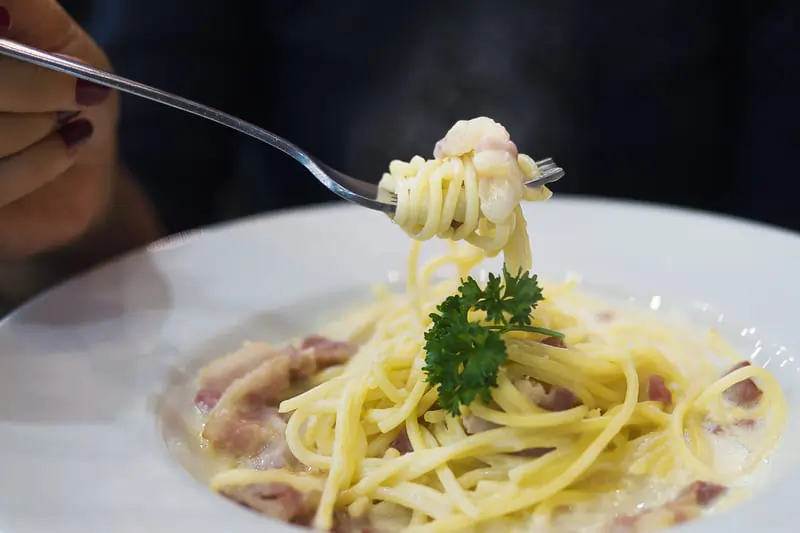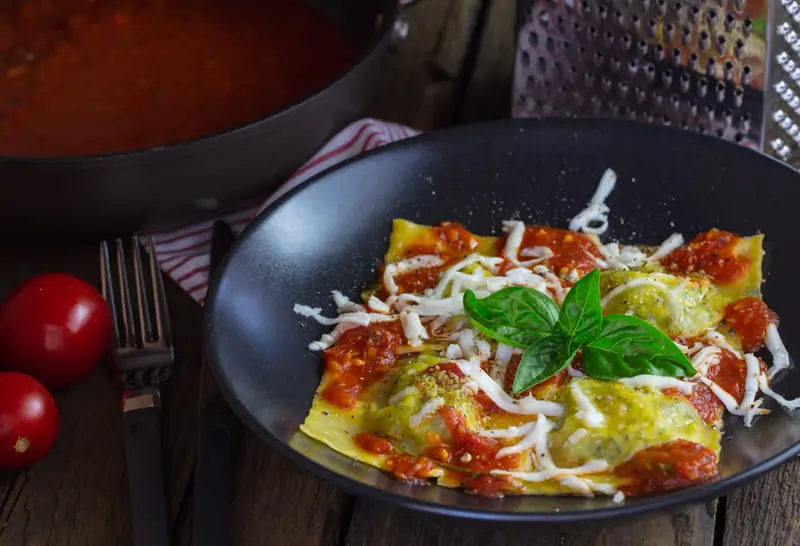The Golden Rule of Mastering Italian Carbonara Recipe
The golden rule of Mastering Italian Carbonara recipe. It is never cook the sauce over direct heat once the eggs are added. This essential technique ensures the eggs don’t scramble and keeps the sauce creamy and smooth. Mastering this requires precise timing and careful temperature control, which are crucial for authentic Italian cooking.
Why Temperature Control Matters For Mastering Italian Carbonara recipe.
Maintaining a consistent, low temperature is essential for a silky Carbonara sauce.
- Mixing the egg and cheese mixture with hot pasta off the heat prevents curdling.
- Using residual heat from the pasta gently cooks the eggs, creating an emulsion instead of scrambling them.
Complementing the Rule with Technique About Mastering Italian Carbonara recipe.
- Whisking the Sauce: Whisk the egg yolks and cheese until smooth before adding them to the pasta.
- Adding Pasta Water Gradually: Reserved pasta water helps emulsify the sauce, balancing consistency.
- Tossing Quickly: Toss the pasta thoroughly with the sauce to ensure even coating.
Summary of the Golden Rule’s Importance
By following the golden rule for Mastering Italian Carbonara Recipe, you’ll achieve the signature creamy texture of authentic Carbonara. Breaking this rule often results in scrambled eggs, which is the most common mistake among beginners.
Core Principles and Techniques for Perfect Carbonara
Mastering Carbonara begins with understanding its core principles. The right combination of high-quality ingredients and precise techniques can elevate this dish from ordinary to exceptional.
Choosing the Right Ingredients for Mastering Italian Carbonara Recipe
The foundation of Mastering Italian Carbonara recipe lies in its carefully chosen ingredients. Each component plays a vital role in achieving the dish’s authentic flavor and creamy texture.
- Pasta: While spaghetti remains the traditional choice, other pasta varieties like fettuccine or bucatini can also complement the sauce beautifully. Bucatini, with its hollow center, captures the creamy sauce, while fettuccine’s flat ribbons offer a satisfying bite. Learn how to pair pasta shapes with different sauces for more insights.
- Guanciale: This cured pork cheek is the heart of Carbonara, providing a smoky, savory depth that defines the dish. Its rich fat renders during cooking, infusing the pasta with flavor. If guanciale is unavailable, pancetta—an Italian cured pork belly—is a suitable substitute. However, for the most authentic experience, guanciale is unmatched.
- Pecorino Romano: This hard, salty cheese is essential for flavor balance, adding sharpness that complements the richness of the sauce. Its granular texture allows it to melt smoothly when combined with the hot pasta. Parmesan cheese can be used in a pinch, but Pecorino Romano’s bold flavor is traditional. Explore the differences between Pecorino Romano and Parmesan cheese to make informed choices.
- Eggs: The sauce’s silky texture depends on fresh egg yolks, which create a rich and creamy emulsion when mixed with the pasta. It’s crucial to use only the yolks for the authentic recipe, as they bind the sauce without making it overly runny.
For a detailed comparison of ingredients between different Italian dishes, read what distinguishes Fettuccine Alfredo from Fettuccine Carbonara.
Techniques to Mastering Italian Carbonara recipe.

After selecting the right ingredients, employing the correct techniques ensures the dish turns out perfectly every time.
- Heat Control: Once the egg mixture is added, avoid direct heat to prevent scrambling the eggs. The residual heat from the cooked pasta and rendered fat is sufficient to cook the yolks gently, creating a velvety sauce. This step is crucial to achieve the desired creamy consistency.
- Pasta Water Magic: Reserved pasta water, rich in starch, is essential for emulsifying the sauce. Add it gradually to the egg mixture while stirring vigorously to achieve a cohesive, glossy sauce that clings to every strand of pasta.
- Quick Mixing: Tossing the pasta immediately with the sauce and guanciale while it’s still hot ensures the ingredients blend seamlessly. Work swiftly to coat the pasta evenly before the sauce cools and thickens.
- Generous Seasoning: Freshly cracked black pepper is more than a garnish—it’s a key ingredient that balances the dish with its subtle spiciness. Don’t skimp on this essential final touch.
By combining the right ingredients with precise techniques, you can recreate a Carbonara that stays true to its Roman roots while delighting the palate. For more tips on achieving culinary excellence, explore our guide to mastering Italian cooking fundamentals.
Step-by-Step Guide to Mastering Italian Carbonara Recipe
Creating authentic Carbonara requires precision and care, but the process is straightforward with the right techniques. Follow these steps to achieve a creamy, flavorful dish that stays true to its Italian roots.
1. Cook the Pasta
- Choose the Right Pasta: Spaghetti is the traditional choice for Carbonara, but bucatini or fettuccine also work well. Their texture allows the sauce to cling perfectly to each strand.
- Boil in Salted Water: Fill a large pot with water, add a generous pinch of salt, and bring it to a rolling boil. Cook the pasta until it is al dente—firm to the bite but fully cooked.
- Reserve Pasta Water: Before draining the pasta, save about a cup of the starchy cooking water. This reserved liquid is crucial for achieving the sauce’s silky consistency. Learn more about why pasta water is a secret ingredient in Italian cooking.
2. Prepare the Guanciale to Mastering Italian Carbonara recipe.
- Dice the Guanciale: Cut the guanciale into small, even cubes to ensure uniform cooking. If guanciale isn’t available, pancetta is an excellent alternative.
- Sauté Until Crispy: In a large skillet, cook the guanciale over medium heat until it becomes golden and crispy. This process renders out the flavorful fat, which serves as the base for the sauce.
- Remove and Reserve: Use a slotted spoon to remove the crispy guanciale from the pan, leaving the rendered fat behind. This fat will coat the pasta and infuse it with a smoky, savory flavor.
3. Whisk the Sauce
- Combine the Key Ingredients: In a mixing bowl, whisk together the egg yolks and grated Pecorino Romano. Add a pinch of freshly cracked black pepper for a subtle spiciness that complements the dish.
- Incorporate Pasta Water: Gradually whisk in a few tablespoons of the reserved pasta water. This step tempers the eggs and creates a creamy mixture that will coat the pasta evenly without scrambling. Explore the role of emulsification in achieving perfect pasta sauces.
4. Combine the Ingredients for Mastering Italian Carbonara Recipe
- Toss the Pasta with Guanciale: Add the drained pasta to the pan containing the rendered guanciale fat. Toss well to ensure every strand is coated with the flavorful fat. Stir in the crispy guanciale pieces for texture.
- Mix in the Sauce: Remove the pan from the heat to prevent the eggs from cooking too quickly. Pour the egg and cheese mixture over the hot pasta and stir vigorously to combine. Gradually add more reserved pasta water, as needed, to create a smooth, glossy sauce that clings to the pasta.
Final Tips for Success
- Work Quickly: Speed is key to ensuring the sauce emulsifies properly. Stir immediately after adding the egg mixture to prevent clumping.
- Adjust Seasoning: Taste the final dish and add extra black pepper or Pecorino Romano as desired for added flavor.
- Serve Immediately: Carbonara is best enjoyed fresh, while the sauce is still warm and creamy.
For more insights into perfecting your technique, read our detailed guide on mastering Carbonara every time.
Avoiding Common Mistakes For Mastering Italian Carbonara recipe.
Even the most experienced cooks can face challenges when preparing Carbonara. The dish’s simplicity leaves little room for error, making it crucial to avoid these common pitfalls. With the right techniques and attention to detail, you can ensure a flawless dish every time.
1. Scrambled Eggs
One of the most frequent mistakes in Carbonara preparation is ending up with scrambled eggs instead of a silky sauce. This happens when the egg mixture is exposed to direct, excessive heat.
- How to Avoid It: Always remove the pan from the heat before adding the egg mixture. The residual heat from the pasta and rendered guanciale fat is sufficient to cook the eggs gently. Stir quickly and continuously to distribute the heat evenly and emulsify the sauce. If you’re uncertain about timing, learn more about controlling heat during sauce preparation to refine your technique.
2. Watery Sauce
A watery sauce can dilute the flavors and ruin the luxurious texture that makes Carbonara so special. This typically occurs when too much pasta water is added to the sauce.
- How to Avoid It: Add the reserved pasta water gradually, starting with just a tablespoon at a time. Stir thoroughly after each addition, observing the consistency of the sauce. You’re aiming for a creamy, cohesive sauce that clings to the pasta without pooling at the bottom of the pan. For additional tips, read our guide on using pasta water effectively in cooking.
3. Clumpy Cheese
Cheese that clumps rather than melts smoothly can create an uneven sauce, detracting from the dish’s overall texture and appearance. This is often due to using coarsely grated cheese or adding it too quickly.
- How to Avoid It: Grate the cheese finely to ensure it melts evenly into the sauce. Incorporate it into the egg mixture before adding it to the pasta, whisking until smooth. Using Pecorino Romano at room temperature can also help it blend seamlessly. Discover the best methods for preparing cheese in pasta dishes.
4. Overcooking the Pasta
Cooking the pasta too long results in a mushy texture that fails to complement the rich Carbonara sauce.
- How to Avoid It: Always cook the pasta to al dente. This firm texture allows the pasta to hold its shape and absorb the sauce better. Set a timer and taste the pasta as it cooks to ensure it’s just right. Learn more about perfecting al dente pasta.
5. Skipping Seasoning Adjustments For Mastering Italian Carbonara recipe.

Carbonara relies on a balance of salty, savory, and spicy flavors. Skipping seasoning adjustments can leave the dish tasting flat.
- How to Avoid It: After mixing the sauce, taste the dish and adjust as needed. Add freshly cracked black pepper for spice or more Pecorino Romano for saltiness. Avoid adding extra salt until you taste, as the guanciale and cheese contribute significant salinity.
For more insights into avoiding these and other common issues, check out our comprehensive guide on mastering Carbonara cooking techniques.
Variations and Adaptations For Mastering Italian Carbonara recipe.
While traditional Carbonara is cherished for its authenticity, modern variations offer creative twists.
Golden Ratios for Ingredients
Perfecting Carbonara often comes down to the right proportions. Here’s a tried-and-tested ratio:
- 1 egg yolk per 100g of pasta.
- 50g of cheese per 100g of pasta.
- 50-100g of guanciale per serving.
For more on proportions, explore how to balance ingredients in Carbonara.
Modern Twists on Carbonara
- Vegetarian Carbonara: Replace guanciale with sautéed mushrooms or zucchini.
- Vegan Carbonara: Use cashew cream or silken tofu to mimic the sauce’s creamy texture.
- Creamy Variations: Some modern recipes add cream, though it’s not traditional.
Frequently Asked Questions About Mastering Italian Carbonara recipe.
What’s the best pasta type for Carbonara?
Spaghetti is traditional, but bucatini and fettuccine are excellent alternatives. For more pasta ideas and comparisons, read about what makes Fettuccine Carbonara special.
Why does the sauce curdle, and how can I prevent it?
Curdling occurs when the sauce is exposed to high heat. Mix off the heat to maintain the silky consistency. Check out this guide on avoiding common Carbonara mistakes for more tips.
Can I substitute Parmesan for Pecorino Romano?
Yes, but Pecorino Romano’s sharpness is better suited to traditional Carbonara. Learn how different cheeses impact classic dishes like lasagna layering.
What’s the difference between guanciale and pancetta?
Guanciale is cured pork cheek with a richer flavor, while pancetta is made from pork belly. If you’re curious about alternative ingredients, explore how Carbonara sauce ingredients differ.
Can cream be added to Carbonara?
While not traditional, cream is sometimes added for a richer texture. For modern adaptations of Italian recipes, see this article on creative pasta twists.
Mastering Italian Carbonara recipe Through Practice
Essential Tips for Beginners
- Use fresh, high-quality ingredients for the best results.
- Practice whisking the egg and cheese mixture for a smooth consistency.
- Focus on timing to prevent overcooking.
For more beginner tips, read how to make perfect Carbonara step-by-step.
Perfecting the Art of Tossing
Tossing the pasta ensures even distribution of the sauce. Look for a glossy finish to confirm the sauce has emulsified correctly. For more advanced techniques, explore secrets of silky Carbonara sauce.
Conclusion
The golden rule of cooking Carbonara—avoiding direct heat on the sauce—is key to mastering this classic Italian dish. By following the right techniques, using high-quality ingredients, and practicing your skills, you can create a Carbonara that rivals even the best Italian restaurants. Whether sticking to tradition or exploring modern adaptations, this dish is a testament to the elegance of simplicity.
For another Italian favorite, explore authentic lasagna layering techniques.

